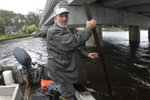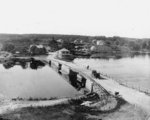Delay threatens Westport's Hix Bridge dredge fund
Town sounds alarm over job that is called critical to river’s health
Town sounds alarm over job that is called critical to river’s health
By Bruce Burdett
The Army Corps of Engineers’ feasibility study into dredging the Westport …
This item is available in full to subscribers.
Please log in to continue |
Register to post eventsIf you'd like to post an event to our calendar, you can create a free account by clicking here. Note that free accounts do not have access to our subscriber-only content. |
Day pass subscribers
Are you a day pass subscriber who needs to log in? Click here to continue.
Delay threatens Westport's Hix Bridge dredge fund
Town sounds alarm over job that is called critical to river’s health
WESTPORT — The Army Corps of Engineers’ feasibility study into dredging the Westport River East Branch near Hix Bridge has taken so long that project advocates fear the promised funding could expire as soon as this spring.
To prevent that from happening, the Board of Selectmen voted unanimously last month to “reprioritize its support for the project and to direct the town administrator to take any steps necessary to facilitate the project.”
“We need to start being a squeaky wheel,” board member Brian Valcourt said. The submerged debris at “this one choke point ... is severely affecting the health of the entire river.”
Town Administrator Tim King said that efforts to dredge debris from around the bridge date back many years, “certainly longer than I’ve been here.
“The Army Corps of Engineers has approved doing a feasability study and that has been a long not-completed first part of this project,” he said.
The Corps committed to that cleanup around eight years ago after it was determined that much of the old concrete debris was dumped into the river under the Army Corps’ watch during various Hix Bridge reconstruction projects, including after the 1938 Hurricane.
Rather than remove the massive bridge supports after the ‘38 hurricane destroyed the span, the builders merely knocked them aside to make way for a new bridge. To this day, granite ands concrete chunks weighing many tons, and flotsam from later bridge jobs, clog the river just north of the bridge.
A key part of the Army Corps’ mission is undoing harm done by government to waterways, and when it prepared to launch its feasability study in 2013, the Corps estimated the cost of the project at around $1 million.
The Corps would pitch in $612,000 of that cost, it said, and an amendment to a state environmental bond bill set aside $387,500 for the state and town shares.
Deborah Weaver of the Westport River Watershed Alliance said that money was reserved by the Department of Transportation to support both the Corps’ feasability study and the actual rubble removal.
“And now we’re at the end of the time period after which that money will become extinct ... That money will go back into the coffers if we don’t get some support to extend the timeline,” she said.
“The Army Corps has taken a lot longer to do the feasability study than anyone ever anticipated,” she said, adding that she understands the Corps is “almost at the tail end” of that study.
Several speakers at the remote meeting stressed the importance of the dredging to the river’s health.
Ken Perez, an Environmental Protection Administration representative and an advisor fo the Watershed Alliance, said that part of the river was once “an ideal habitat for oysters.” A thriving oyster fishery back in the 1800s produced 50 or more bushels daily, “a resource that is being jeopardized by the rubble.”
Water depths around the Hix Bridge crossing are typically around 30 feet but have shallowed to less than 10 feet due to the dumping.
“The flow of water is dramatically restricted and oysters need a lot of flow of water,” Mr. Perez said. “They are basically being smothered to death by organic matter that builds up on the bottom.”
In places, water depths are considerably less than 10 feet. Back in 2013, shortly before his death, James “Crab” Manchester took Shorelines on a tour of waters around and beneath the bridge. At one point he pulled up his outboard and poled his way through so as to spare the propeller from concrete chunks just beneath the surface.
“There used to be plenty of water there, all the way across — never had to worry about your motor,” said Mr. Manchester, a member of the town Shellfish Commission and the self-proclaimed oldest shellfisherman on the river.
“There’s rock and old rebar all over the place there,” he added. “You don’t even want to try to motor through there except through the (east side) channel.”
Mr. Valcourt had similar recollections.
When he went crabbing in the upper river years ago, “you could go all around ... Now, the flats are closing in, it’s getting shallower. You have to be very careful where you go” other than at high tide.










